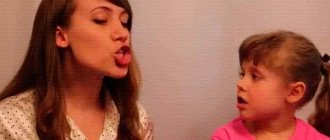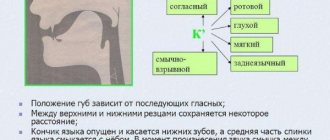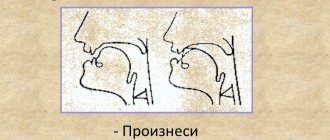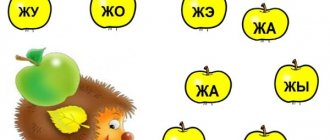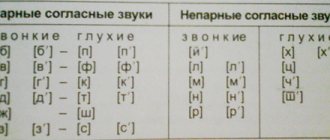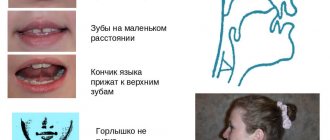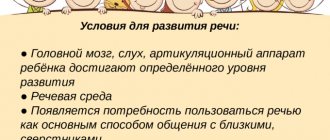In speech therapy there is the concept of sound automation. In relation to the formation or correction of a child’s speech skills, this is the development of a complex ability to recognize a sound by ear, recognize it in a word, and also pronounce it freely and correctly in various positions.
It’s good when children’s speech development is monitored by professionals. But solving some problems is within the capabilities of parents armed with knowledge.
The lesson notes on audio automation B can be viewed here.
Summary of educational activities for speech development “Sounds [G], [G']; Letter "G"
Articulation of the sound G
Mastering any speech sound is a gradual process. First, isolated pronunciation is developed, it is clarified and stated. And parents are unlikely to be able to help their child if they themselves do not know how a particular sound is formed.
IMPORTANT! Age-related difficulties with the pronunciation of the posterior palatal (rear lingual) consonant sounds G, K and X are in many ways natural. Even just activating the root of the tongue and coordinating its interaction with the back of the palate can be difficult for a baby. Indeed, outside of speech activity, muscle motility in this part of the oral cavity is mainly of a reflex nature and does not require conscious control.
Articulation is the control of the conditions necessary to pronounce a sound. In the process of automation, stable patterns of interaction between parts of the speech apparatus are developed. This relieves the speaker of the need to constantly monitor the articulation process; it is actually programmed.
In the “Broca's area” of the cerebral cortex, commands are given, after which the necessary conditions for pronouncing a specific sound in a specific position are reproduced automatically.
This concerns not only the “obstacles” in the mouth and the general configuration of the oral cavity, but also the characteristics of the air stream, as well as the condition of the vocal cords, which are used to form vowels and voiced consonants.
Now specifically about the sound G. The previous stage in its production should be mastering the sound K, since from the point of view of articulation they are very close:
- lips and teeth are open and in a neutral position;
- the tip of the tongue lies and does not touch the lower incisors;
- the back of the tongue meets the palate;
- the lateral edges of the tongue touch the upper molars;
- The soft palate is raised and pressed against the back wall of the nasopharynx.
The difference lies in the participation of the voice and the characteristics of exhalation. In addition to the above conditions, when pronouncing the sound G:
- the ligaments close and vibrate;
- the air stream does not have such an impulsive and explosive character.
Features of articulation G' (soft sound):
- the back of the tongue is sharply curved in the middle part and touches the hard palate;
- the tip of the tongue approaches the lower incisors;
- the corners of the mouth are pulled back;
- lips press against incisors.
IMPORTANT! Articulation of the G sound in conjunction with other subsequent sounds is a little more difficult than its own sound, but isolated. Any sound following G determines what shape the lips take, and vowels additionally affect the distance between the incisors.
Possible deviations and disorders for which it is strongly recommended to consult a speech therapist:
- noticeable distortion of the G sound or its absence (gammatism);
- replacing the sound G with another consonant - K, D and the corresponding soft ones (paragammatism).
The causes of gammatism and paragammatism can be both insufficient development of the muscles of the tongue and congenital structural features of the palate. Sometimes behind these speech defects there are pathologies of phonemic (sound recognition) and physical hearing or a violation of the innervation of the language. Thus, these speech defects cannot be left unattended. Along with a speech therapist, the problem may fall within the competence of a pediatrician or neurologist, as well as other medical specialists.
Setting the sounds “k” and “g” methodological development on the topic
Sounds K, Kb, G, Gb, X, Xb
| Normally, the formation of the correct pronunciation of the sound K occurs by two years (M.F. Fomicheva). When pronouncing the sound K, the lips are neutral and take the position of the next vowel. The tip of the tongue is lowered and touches the lower incisors. the front and middle parts of the back of the tongue are lowered, the back part closes with the palate. The lateral edges of the tongue are pressed against the back teeth. The soft palate is elevated and closes the passage into the nasal cavity. Vocal cords are open. The exhaled stream explodes the closure between the tongue and the palate, resulting in a characteristic noise. With the articulation of G, the participation of the vocal folds is added. the force of exhalation and the tension of the organs of articulation are weakened compared to K. When articulating the sound X, in contrast to K, the back of the tongue completely closes with the palate: a gap is created along the midline of the tongue, through which the exhaled air produces noise. When pronouncing soft Кь, Гь, Хь, the tongue moves forward and makes a stop with the palate (and for Хь - a gap). The middle part of the back of the tongue approaches the hard palate. The front is down. The tip of the tongue is slightly closer to the lower teeth, but does not touch them. The lips stretch somewhat and reveal the teeth. Sound setting [k] By imitation: the child is asked to curve his tongue into a “slide”, press it to the palate and, without lowering it, blow the cotton ball off the back of the hand brought to his mouth => [k]. If imitation fails, then mechanically mechanically using a finger or spatula, based on the sound [t]. The child is asked to pronounce the syllable ta. At the moment of pronunciation, the teacher presses his finger on the front part of the back of the tongue, resulting in the syllable cha. Then the teacher moves the finger a little deeper, resulting in the syllable kya. Finally, the third stage - even deeper pressure on the tongue - gives a hard sound - ka. The production of the sound [g] from DA is similar; [x] from SA. To produce back-lingual sounds, it is recommended to: “cough” and, under visual control, focus the child’s attention on the new sound (kh) Sound setting [g] Production of the sound /G'/ by imitation. The child is asked to put his hand on the neck and, “turning on” his voice, pronounce the sound /K Staging the sound /G/ with mechanical assistance. The child is asked to say “yes - yes - yes”, while the speech therapist moves the tongue back with a spatula until the sound combinations “yes - yes - ha” are heard. Sound setting [x] Production of the sound /X/ by imitation. A). The sound /X/ is easily evoked by imitation using a play technique: “Open your mouth wide and breathe on your hands, “warm them.” In this case, the speech therapist makes sure that the tip of the child’s tongue is at the bottom, and the back part rises steeply, but does not touch the palate. You can, for example, first invite your child to make a “low slide”, and only then “let the breeze”. b). You can offer your child a funny picture or toy to make him laugh, laugh with him, and then draw his attention to the laughter: we laugh “ha-ha-ha.” We fix the sound /X/ in combination with other vowels (O, E, Y). Staging the sound /X/ with mechanical assistance. If it is not possible to produce a sound by imitation, it can be produced with mechanical assistance, that is, using a probe to move the tongue deeper into the tongue. We ask the child to pronounce the syllable “sa”, with the correct position of the tongue it will turn out “sa-sa-ha-ha”. Setting the sound /X/ from the correct /K/. The child is asked to pronounce the sound /K/ often and protractedly. At this time, the combination “kh” is obtained. It is necessary to draw the child’s attention to the fact that after the sound the sound /X/ is heard, after which we tear off /K/ from /X/. It turns out /X/. Articulatory gymnastics for the posterior lingual sounds K, Kj; G, Gy; X, Xx; Y 1. Bite your tongue. • Smile, open your mouth slightly and bite your tongue. 2. “Punish the naughty tongue” • Smile, open your mouth slightly, put the wide front edge of your tongue on your lower lip and “slap” it with your lips, saying “five-five-five.” (Alternate exercises No. 1 and No. 2) 3. "Spatula" • Smile, open your mouth slightly, and place the wide front edge of your tongue on your lower lip. Hold it in this position for a count from 1 to 5-10. 4. "Gorka" • Smile, open your mouth, the tip of your tongue rests on your lower teeth. Curl your tongue, resting the tip of your tongue on your lower teeth. 5. “We’ll build a slide, we’ll destroy the slide” • Smile, open your mouth, the tip of your tongue rests on your lower teeth. Curl your tongue, resting the tip of your tongue on your lower teeth, then relax it. Perform these movements alternately. 6. “The wind blows from the hill” • Smile, open your mouth slightly. Place your tongue in a “slide” position, and then calmly and smoothly blow along the middle of your tongue. The air should be cold. |
Kappacism is the name given in speech therapy to defective reproduction of the sounds [K], [K']. Gammacism is the incorrect pronunciation (replacement) of the sounds [Г], [Г'], hitism is the distortion or replacement of the sounds [Х], [Х']. Recently, such ... -cisms are found more and more often in children.
Causes of Kappacism, Gammacism and Chitism
The sounds [К], [К'], [Г], [Г'], [Х], [Х'] suggest a high rise of the root of the tongue. That's what they're called: back-lingual. And if this very rise is not there? Why does this happen? Perhaps the root of the tongue is poorly expressed, so its upward movement is limited. It is possible that at the root of the tongue there is hypotonia (lethargy) or paresis (partial impairment of mobility due to birth trauma, intoxication, etc.).
Another reason for the absence or distortion of back-lingual sounds is the palate. Its structure is different. If the hard palate is gothic, narrow or slit-like, the root of the tongue simply cannot reach it. With rhinolalia (splitting of the hard and soft palate: “cleft lip”, “cleft palate”), the correct pronunciation of sounds is generally difficult. But this is a separate conversation. In such cases, errors in sound pronunciation are a manifestation of mechanical (organic) dyslalia, or rhinolalia.
3. Lazy language
If there is nothing like that, the child’s tongue is simply lazy. He doesn’t bother himself with hard work and chooses a lighter version of pronouncing back-lingual sounds: replacing them with front-lingual sounds [t], [t'], [d], [d'], or omitting them altogether. To correctly pronounce the sounds [K], [K'] [G], [G'], you need to work hard: raise the back of the back of the tongue, rest it against the soft palate, touch the lateral edges of the tongue to the hard palate. And on the sounds [Х], [Х'] - to form a narrow gap between the highly raised root of the tongue and the soft palate. Oh, how difficult! With the help of games and exercises you can motivate the “lazy person”!
4. Methods of sound production [K]
Exercise “Tongue wrestler”:
An adult and a child sit in front of a mirror. The child's tongue turns into a fighter who fights with... the index finger of an adult (the finger is pre-washed and wiped with alcohol, you can wrap the finger in a clean handkerchief). The fight is going to be fun, so the child is sure to smile, his mouth is slightly open. The adult rests his finger on the tip of the baby's tongue. Then he pushes his entire tongue back... The kid (tongue-wrestler) tries to push the opponent off the “carpet.” In this case, the back of the tongue rises. But, alas... All efforts are in vain. The opponent won. Meanwhile, the adult places his finger on the front of the back of the tongue and moves it even further. The tongue resists with all its might! No, this is not a defeat after all. The child’s tongue took the desired position, its root rose, and the baby himself felt a high rise - a “hill” of the back of the tongue. This is already a victory! A similar struggle is waged until the child’s tongue learns to independently make and hold the “hill.” If the actions of an adult are incorrect (too harsh), you can cause a gag reflex in the child. Therefore, be careful and carefully monitor your baby's reaction.
Exercise “Skating from the mountain”:
Before starting to master it, the child must independently hold his tongue in the “hill” position. A cotton ball is placed on the child’s palm. The baby opens his mouth slightly, holds the root of the tongue in a raised position (“mound”), at the same time the tip of the tongue is lowered. Then he exhales air jerkily (“like a shot”), blowing the cotton ball off his palm. When performing this exercise, you should get the sound [K]. Perhaps the desired result will be obtained after several attempts.
Exercise "Spoon":
If it was not possible to produce the sound [K] using the previous exercise, try using another method. Take a teaspoon. Invite your baby to pronounce the syllables: TA-TA-TA... Using the handle of a spoon, move the tongue away, gently pressing on the front of its back. The pressure should be applied at the moment when the baby pronounces the sound [T]. At the sound [A], the spoon is removed. One more clarification. The child pronounces the syllables TA-TA-TA… slowly, opening his mouth quite wide “in a smile.” Only in this case will an adult be able to successfully use a spoon. Depending on the degree of advancement of the tongue, the syllable “TYA” may first appear, then “KYA”. Continue to press evenly on the tongue, catch the moment when the long-awaited “KA” sounds clearly. The child himself must remember this position. Perhaps not the first time. Consolidate your success. The result is considered achieved when the child independently pronounces the syllable “KA” without the help of a spoon.
How to put the sound [G]?
The sound [G] is placed in the same way, but from the syllable “DA”. That is, the voice is connected (the sound [G] is ringing). If a child, in addition to defects in back-lingual sounds, also has defects in deafening (replacement of voiced sounds with voiceless sounds: “tom” - house, “subs” - teeth, “shuk” - beetle, etc.), this will be problematic. An adult will first have to tell a child such a fairy tale.
Fairy tale "House for the Voice"
Every person has a throat, and you have one too. A VOICE lives in the neck. When he sleeps, for example, with deep sounds [К], [С], [Ш], [Ф], [П], the walls of his little house do not tremble. These sounds are dull not because they don’t hear anything. There's just no voice in their sound. But on the ringing sounds [G], [Z], [SH], [V], [B], the VOICE wakes up and begins to knock on the walls, causing the neck to vibrate. Do you want to check?" Place the back of one of the baby's hands against your throat. Say some unvoiced sound, for example [T]. A very common mistake to avoid. You must reproduce only the isolated sound [T], and not the name of the letter [Te], or [Ta]. Adding a vowel will cause vibration in the throat (there is always a voice when pronouncing vowels) and will disorient the child. So, you uttered the sound [T]: “You feel, baby, the VOICE is sleeping!” And now, - [D]: “The VOICE has woken up!” Do the same with other paired consonants: [S] - [Z], [Sh] - [F], [F] - [V], etc. Now the child should put his hand to his throat, pronounce the sound [T] and feel the absence of vibration. For the sound [D] to appear, you need to connect a voice. The little one tries to call him. Finally, it was possible. Now you can start making the sound [G] from the syllable “DA”.
Setting the sound X
1. From the sound SH mechanically, moving a spatula (probe) or the handle of a teaspoon along the back of the tongue deep into the oral cavity SH-SH-HH-X or SA-SHCHA-HYA-HA
2. From the sound K. Pronounce the sound K with aspiration, i.e. K is not sharp, explosive, but smooth with the opening of the bow and its transition into the gap KXXXX.
3. By imitation (if there is no sound). Imitation of warming hands with breathing.
9. Sounds [X], [X']
Are the sounds [Х], [Х'] still missing? Try to imitate them. It will not be difficult for you or your child to imagine severe frost (memories of the January and February cold are still fresh!). What happens to your hands on the street? That's right, they are freezing. Hands need to be warmed. Bring your palms to your mouth and blow warm air on them. The sound [X] will be heard. The baby does the same. Everything worked out? The hands got warm and the sound sounded? If the second one fails, grab a spoon. You move your tongue, and the child pronounces the syllables: SA-SA-SA…. The sound production technology is the same as with [K]. Here, too, there may be intermediate options: SY and HY. But, as a result, still HA! Reinforce what you have achieved on syllables (HA, HO, HU, HI, HE), words (tail, hut, cunning, sugar, poetry, etc.)
It would not be superfluous to train the child in selecting words with the sound [X]: elephant - elephantKha, walrus - walrusKha, wild boar - boarKha, ostrich - ostrichKha, beaver - beaverKha, hedgehog - hedgehogKha, parrot - parrotKha, etc. (the child himself must choose the second word of the pair, you just give a sample hint). The same thing, with pairs of words: swimmer - swimmer. watchman - watchmen, coward - coward, tailor - tailor, etc.
Automation of the G sound in syllables
In this exercise, the child is asked to listen, remember and pronounce various syllables and their sequential combinations. The transition from simple to complex is observed.
Combination of G with vowel sounds:
- ha-ha;
- ho-ho;
- goo-goo;
- ga-go-gu;
- uh-huh-uh-huh.
Syllables involving other consonants:
- gwa-gwo-gwu;
- gla-glo-gloo;
- sga-sgo-sgu;
- rga-rgo-rgu.
For G' (soft sound):
- ge-ge;
- gi-gi;
- gli-gli-gli;
- gree-gree-grie.
Master class for parents “Producing sounds at home”
Anna Ignatieva
Master class for parents “Producing sounds at home”
Good afternoon, dear parents . Today I want to share my experience with you and talk about making sounds at home .
sounds are formed due to the work of our articulatory apparatus. You can see all its components on the slide. But it is necessary to emphasize that when making sounds with children , I draw their attention to such elements as: lips, teeth, tongue and vocal folds. The child must know what these organs do when pronouncing the sound they are working on. But it is not always possible for a child to give the tongue the posture that is necessary to pronounce a sound . In this case, articulation gymnastics comes to the aid of the speech therapist and you, parents . Let's take a closer look here.
What is articulatory gymnastics? This is a set of special exercises aimed at strengthening the muscles of the articulatory apparatus, developing strength, mobility and differentiation of movements of the organs involved in the speech process. As a rule, the main goal of articulatory gymnastics is to strengthen the muscles of the tongue. After all, the tongue, from an anatomical point of view, consists of longitudinal and transverse muscles. The first group of muscles shortens the tongue and makes it longer. She also helps to take him aside. The second group allows you to make the language wider or narrower.
Today we will not discuss the production sounds of the Russian language without exception . Let’s discuss those that are most often impaired in children. These are three groups of sounds : whistling, of which today we will analyze the sounds (s, z, hissing, let's talk about the sounds (sh, zh)
and some sonorant
sounds (р,л)
.
Group of whistling sounds
The work of the organs of the articulatory apparatus when pronouncing the sound C :
• Lips - in a smile;
• Fenced teeth with a small gap;
• The tongue is wide, behind the lower teeth;
• Voice - turn off;
• Air stream - cold, directed down the middle of the tongue (along the groove)
.
The work of the organs of the articulatory apparatus when pronouncing the sound Z :
• Lips - in a smile;
• Fenced teeth with a small gap;
• The tongue is wide, behind the lower teeth;
• Voice - turn on;
• Air stream - cold, directed down the middle of the tongue (along the groove)
.
Preparatory exercises for making whistling sounds :
(The main task is to teach the child to direct the air stream in the center of the tongue, as well as to accept the lower position of the tongue)
• "Fence"
- smile without tension so that the front upper and lower teeth are visible.
• “Window” (hippo)
- smile slightly and open your mouth wide.
• "Pancake"
- smile, open your mouth and stretch your wide tongue to your chin.
• "Tube"
— roll the tongue into a tube, bending its edges.
• "Monkey"
- open your mouth slightly, place your tongue between your lower teeth and lower lip. The lips are brought together.
• "Slide"
- open your mouth wide, grab the bottom teeth with the tip of your tongue and push your tongue forward.
• "The wind blows from the hill"
- take the
“slide”
, then calmly and smoothly blow along the middle of the tongue. It is necessary to ensure that the air stream is cold and directed downward.
• “Brushing the lower teeth”
- take the
“window”
, use the tip of your tongue
to “brush”
your teeth from the inside.
• "Coil"
— take the
“slide”
,
“roll out”
forward and move it deeper
(pump the slide)
.
Making whistling sounds:
a) by imitation (preferred, but not often feasible method)
;
b) from I, T with aspiration.
c) from the “slide”
.
We ask the child to blow on the tongue, while holding a cotton swab in the middle of the tongue (where the groove runs)
.
Group of hissing sounds
The work of the organs of the articulatory apparatus when pronouncing the sound Ш :
• Lips are slightly rounded;
• Teeth-fence with gap;
• Tongue - performs the “cup”
;
• Voice - off;
• The air stream is warm, directed upward along the middle of the tongue.
The work of the organs of the articulatory apparatus when pronouncing the sound Zh :
• Lips are slightly rounded;
• Teeth-fence with gap;
• Tongue - performs the “cup”
;
• Voice - on;
• The air stream is warm, directed upward along the middle of the tongue.
Preparatory exercises for making hissing sounds :
(The main task is to teach the child to lift up not only the tip of the tongue, but also its lateral edges)
• "Fence"
- smile without tension so that the front upper and lower teeth are visible.
• “Window” (hippo)
- smile slightly and open your mouth wide.
• "Pancake"
- smile, open your mouth and stretch your wide tongue to your chin.
• "Cup"
- open your mouth wide, take out your wide tongue, lift the tip and side edges of the tongue.
• "Delicious jam"
-smile, open your mouth and lick your upper lip with your tongue in a
“cup”
. Movements are directed from top to bottom. You need to make sure that the lower jaw is motionless.
• “Brushing the upper teeth”
-smile, open your mouth slightly, show your teeth and with a wide tongue imitate the cleaning movements of a toothbrush.
• "Swing"
-smile, open your mouth. Place your wide tongue on your lower lip, then lift your tongue up, as if trying to reach the tip of your nose. Alternate movements.
• "Fungus"
-suck your tongue to the palate so that the hyoid frenulum stretches. Hold the pose.
• "Focus"
- Place a piece of cotton wool on the tip of your nose.
The tongue takes the shape of a “cup”
. Blow the cotton wool off your nose. We monitor the child’s breathing: we take in air through the nose, exhale through the mouth.
Staging:
a) by imitation with visual and auditory control;
b) using special techniques:
- from R-R-R in a whisper with a gradual rounding of the lips and bringing the teeth closer together;
- from T-T-T with strong aspiration and raising the tongue upward.
(To produce the sound Zh, the same techniques are used, only with tactile-vibration control).
Group of sonorous sounds
The work of the organs of the articulatory apparatus when pronouncing the sound L :
• Lips are open, taking the position of the subsequent vowel;
• Teeth - open;
• Tongue - pushes the upper teeth and runs into the mouth;
• Voice - turn on;
• Air stream passes freely on the sides.
The work of the organs of the articulatory apparatus when pronouncing the sound R :
• Lips are open, taking the position of the subsequent vowel;
• Teeth - open;
• Tongue - performs the “fungus”
, and the wide tip vibrates;
• Voice - turn on;
• The air stream is strong and passes over the tongue.
Preparatory exercises for producing sonorous sounds :
(The main task is to teach the child to lift the tongue up and hold it, as well as stretch the hyoid frenulum)
• "Fence"
- smile without tension so that the front upper and lower teeth are visible.
• “Window” (hippo)
- smile slightly and open your mouth wide.
• "Pancake"
- smile, open your mouth and stretch your wide tongue to your chin.
• "Sail"
- smile, open your mouth wide, hold the tip of your tongue behind your upper teeth.
• "Painter"
-smile, open your mouth and
“paint”
the sky (
“ceiling”
) with the tip of your tongue, moving your tongue back and forth.
• "Turkey"
- smile, show your teeth, open your mouth slightly, put your wide tongue on your upper lip and make quick movements with the tip of your tongue along the upper lip back and forth, trying not to lift your tongue from the upper lip.
Then turn on the voice. The result will be a funny sound , similar to “bl-bl.”
.
• "Horse"
- smile, open your mouth wide, click the tip of your tongue at the top. Speed up the pace. Make sure that the lower jaw does not move.
• "Fungus"
- suck your tongue to the palate so that the hyoid frenulum stretches. Hold the pose.
• "Machine gun"
- open your mouth wide,
place your tongue behind your upper teeth. Repeat loudly, clearly, repeatedly: “D-D-D.”
.
Gradually speed up the pace .
The lower jaw does not move. Setting L :
a) by imitation (extremely rare)
.
b) from the sound U- with the tongue sticking out between the outstretched lips, at the same time the lips are parted with the fingers.
c) from the sound Y - with a bitten tongue.
Statement P:
a) from a prolonged Z-Z-Z with the tip of the tongue raised.
b) from prolonged J-J-J with lips stretched out in a smile.
c) from quickly and repeatedly repeating D-D-D while creating vibrations under the tongue using a cotton swab.
d) from the “fungus”
. We ask the child to blow on the tongue with all his might. We take in air through our nose and exhale through our mouth.
To reveal greater interest in classes, you can conduct articulation gymnastics in the form of a fairy tale. After all, the leading activity for our children now is play. You can involve your child’s favorite fairy-tale characters in this fairy tale. And for example, I suggest you play a fairy tale about the cheerful Tongue and his friends. Please repeat after me.
Once upon a time there lived a gnome, Tongue. He lived behind a fence (we do the exercise “Fence”
).
One morning, Tongue woke up and opened the window ( "Window"
, looked out and looked left, right, up, down (
"Clock"
,
"Swing"
). What a good morning Tongue thought and decided to bake pancakes for breakfast. He began to knead the dough (
" Knead the dough
." He baked a lot of pancakes and began to chew them (
"Naughty Tongue"
). Then someone
knocked ( "Hamster"
). It was his friends who came: Frog (
"Fence"
, Elephant (
"Tube"
) and Hippopotamus (
“Window”
). He also treated them to pancakes (
“Naughty Tongue”
, and even with jam (
“Tasty Jam”
). He poured tea into the guests’ cups (
“Cup”
). They ate and brushed their teeth (
“Cleaning” teeth"
).
They decided to go for a walk. They rode on horses ( "Horse"
).
We galloped and galloped and saw a swing, how great it is to ride on a swing with friends ( “Swing”
! We rode and galloped on (
“Horse”
)). We found a fungus (
Mushroom
We picked a mushroom and galloped on (
“Horse”
). Suddenly we saw an angry turkey who chattered menacingly (
"Turkey"
). They got scared and galloped home (
"Horse"
). And
at home, the friends remembered that they wanted Yazychka to renovate the apartment and paint the ceiling ( "Painter"
). The friends got tired and went home. Tongue closed the fence (
“Fence”
) and went to bed.
This is how you can conduct articulation gymnastics classes in a playful way. Such activities will not bore your child.
Automation of the G sound at the beginning of words
Listen and repeat clearly, highlighting G:
- gas, lawn, newspaper, din, hammock, gamut, smoky, accordion, harbor, tie, clearance;
- goal, hunger, voice, dove, head, rut, race, hounds, racer, year, anniversary, gop, hopak, grief, hill, city, pride, gorilla, dialect, beef, guest, gift;
- hum, goulash, goose, caterpillar, herd, lips, sponge, beep, threshing floor, thicket.
For G' (soft sound):
- Gene, genius, Hera, geranium, coat of arms, herbarium, Huck, gel;
- guide, hydrant, weight, anthem, gymnast, hypnosis, guitar, giant, hyena.
IMPORTANT! It is necessary to explain to the child any word he does not understand, thereby expanding his vocabulary and making the “training” process meaningful. What the baby understands is better remembered by him.
Consolidating the sound G in a child’s speech
Most speech therapists and speech pathologists consider the concepts of “consolidation” and “automation” as identical.
Sometimes sound consolidation is understood as the step-by-step work process of comprehensive development of a phonetic unit, and automation is the achieved complex result.
The bottom line is that consolidation (automation) means going through a sequential set of various speech exercises that help the child reliably learn a relatively fragile spoken sound.
Each new phonetic image or ideomotor (articulatory) template is especially fragile if the clarification and production of the correct sound was preceded by getting rid of its defective version.
An important aspect of consolidating a speech sound is the need to “test” its use in various arbitrary phrases and sentences, as is what happens in real speech. Below are examples of such exercises.
How to teach a child to say the letter B
Speech therapy in a preschool educational institution is needed so that the child can go to the junior grade at school with good pronunciation. Difficulties arise when placing different letters, including the letter [v].
Group lesson in the garden
Articulation gymnastics
In order for your baby to be able to pronounce the letter “v” normally, you need to do the following:
- the training begins with the phrase “the wind howls.” The teacher shows the child how to bite the lower lip when pronouncing in order to produce a sound;
- it is important to explain that the lower lip is only slightly bitten by the teeth during a conversation;
- if this does not work, the speech therapist lightly presses his finger on the lower lip.
Additional Information! When pronouncing the sound “v”, the articulation is the same as when pronouncing “f”, it is only important to close the vocal cords.
Exercises for sound production
Before entering kindergarten, a child must learn to pronounce words with “v.” Violations are rare, only in the presence of lip defects.
Practicing sounds with exercises
Exercises:
- Raise your upper lip several times.
- Lower your lower lip.
- Make a “fence”.
- Pull your lips inside your mouth, pressing them against your teeth.
Individual speech therapy support programs for children
After articulation exercises, the child should pronounce the words several times: “wolf”, “wind”, “rope”.
Tasks for automating the pronunciation skill [вь] and [в]
Conducting a sound lesson in the senior group, the speech therapist achieves automatic pronunciation, as a result of which sounds are differentiated. After a year, the child should go to school, where it is possible to continue working on speech, but sounds such as “v” and “f” should be worked out as early as possible.
Exercises are performed at the preschool educational institution and given at home:
- the lower lip approaches the upper teeth and exhales; you can ask the child to pretend to be a rabbit and slightly expose the upper row of teeth;
- to practice “f”, softness is added to “v”.
Additional Information! To automate the skill, the child must read words containing “v” and “f”: muskrat, exit, farm, purple, focus, wind, pinwheel.
Automation of the G sound in pure tongues
Pure sayings are easy-to-remember comic similarities to nursery rhymes or counting rhymes that are well suited for the role of exercises. Pure tongues begin with the repetition of several syllables, where attention is focused on the sound being reinforced.
Composing phrases yourself is a good way for parents to creatively approach the development of their child’s speech. It's better if they make at least a little sense. Here are some examples.
- Ha-ha-ga, ha-ha-ha, - the geese go to the meadows.
- Oh-ho-ho, oh-ho-ho! - There is nothing in the cave.
- Goo-goo-goo, goo-goo-goo, - the owl is hiding in a haystack.
- E-ge-ge, e-ge-ge! - we are running along the rainbow.
- Gi-gi-gi, gi-gi-gi, they call us for pies.
Finally
G is just one of the speech sounds. And it’s far from the only one that causes difficulties for young children. When working with a child, we must remember that an adult’s speech must be clearly intonated, and the external features of articulation must be clearly distinguishable.
You should not repeat defective scale patterns after your child. It is useful to show examples of correct speech several times. It is recommended to stimulate the child’s speech with questions.
Related posts:
- Rhoticism in speech - complete information Rhotacism (problem with the sound [P]) is the most common disorder in children...
- The sound “Zh” - from production to automation Automation of the sound “Zh” begins with identifying the reasons that interfere with the correct sound pronunciation...
- A child does not know how to say R - we’ll show you how to teach it. To teach a child to pronounce the letter R, you need to regularly perform special...
- Signs of glasnost in the Russian language All speech sounds are divided into vowels and consonants, between them...
IV. Production of posterior lingual sounds.
Rear lingual sounds are produced by imitation or with mechanical assistance from basic sounds (Fig. 1): Fig. 1
SOUND [K]
1. By imitation.
a) Sometimes, as a result of well-organized preparatory work, it is possible to produce the sound [K] by imitation. The speech therapist in front of the mirror gives a sample of the articulatory structure of the sound [K], but does not pronounce the sound, so as not to trigger the child’s habitual defective articulation. The child is asked to reproduce the correct articulation of the sound [K] and blow the cotton wool from the palm of his hand brought to his mouth, the main attention is paid to the place of formation of the closure of the back of the tongue with the palate, as well as the formation and strengthening of a directed oral air stream. All work is carried out under constant visual, auditory and tactile control.
b) We draw a figurine and imitate a chicken.
2. With mechanical assistance
Setting [K] FROM Sound [T]. a) With this method of production, the child is asked to pronounce the syllables “ta-ta-ta” several times, opening his mouth wide. At the moment of pronouncing the syllable, the speech therapist uses a spatula or a special speech therapy probe No. 5 (see Fig. No. 3)
Probe No. 5 Fig. 3
Rice. 4 . Stages of sound production
from the sound
t.
With this method of setting, tactile control is constantly connected. After the child begins to easily and quickly pronounce the syllables “ka-ka-ka” using a probe or spatula, with the mechanical help of a probe or spatula, mechanical assistance is gradually eliminated.
b) Setting [K] from [X].
When pronouncing the sound [X] for a long time, lightly press the bottom of the mouth in the area of the root of the tongue with your thumb until the sound [K] is produced.
c) Setting [K] from [K'].
The child is asked to pronounce the syllable “kya”; at the moment of pronouncing, the speech therapist using probe No. 5 gradually moves the tongue back by pressing on the front part of the back of the tongue. First the syllable “kya” is heard, then “ka”.
Sound [K']
By imitation.
a) The speech therapist shows the child the correct articulation of the sound [K] and suggests slightly moving the tongue forward and tightening the lips. The child reproduces the proposed articulatory structure with the constant use of all types of control; constant comparison of the sensation of one’s own sound production and the sound of a sample.
b) Setting [K'] from [K].
The sound [K'] can be called up immediately after automating the sound [K] in combination with the vowel sounds [I], [E], [I], making sure that the lips stretch into a smile.
It is necessary to pay attention to the fact that the child correctly performs the installation with this sound: the tip of the tongue must be kept at the lower teeth, as with “I”: The teeth are brought together (2 mm), exposed in a “smile.” The air stream goes exactly through the middle of the tongue when bowing. You can check: I – CH – CI. When bowing, the back of the tongue (middle part) touches the palate and drops sharply. You cannot press this part against the palate for a long time, because otherwise the air will flow along the edges of the tongue and you will hear a squelching sound. The child pronounces the first syllable in the word “kisa” with tension. Then we try to pronounce this sound separately with the child “Кь,КьКь”
With mechanical assistance.
Setting [K'] from [T'].
The child is asked to pronounce the syllable “tya-tya-tya” several times in a row. At the moment of pronouncing the syllable, the speech therapist, using a spatula or probe No. 5 (see Fig. 2), gradually moves the tongue back, pressing on the front part of the back of the tongue. As you move deeper, you can hear the syllables “kya-kya-kya.”
Probe No. 5
Fig.
2 Sound [G]
By imitation.
a) The performance should consist of showing and explaining the difference between the sound [G] and the sound [K]. In this case, it is useful to put the child’s hand on the neck and give him the opportunity to feel the vibration of the larynx and the movement of the anterior wall of the pharynx, which occurs under the pressure of the air that accumulates in it before the air explodes.
b) Setting [G] from [K].
The sound [G] can be obtained by voicing the sound [K]. To do this, the child is offered the following table:
| AND | AND | And - quietly | A A A - quiet |
| AND | AND | And - loud | A A A - loud |
| 0 | 0 | 0 – quiet | K K K - quiet |
| 0 | 0 | 0 – quiet | G G G - loud |
Vowel sounds are pronounced briefly, abruptly, with a firm attack. By analogy, in some cases, after pronouncing a quiet dull sound [K], a loud voiced sound [G] sounds. In this case, it is necessary to put your hand on the child’s neck (above the larynx) and give him the opportunity to feel the vibration of the pharynx, which occurs under the pressure of the air accumulating in it until the air explodes.
With mechanical assistance.
Setting [G] from [D].
The child is encouraged to pronounce the syllable “da-da-da”, while at the same time we press with a spatula or probe No. 5 (see Fig. 1) on the front part of the back of the tongue. The syllable “da” is successively transformed into the syllable “dya”, then into “gya”, and finally into “ga”.
Probe No. 5
Fig.
1 Sound [G']
By imitation.
a) The speech therapist asks the child to pronounce the sound [G], and then after a pause - the sound [I]. When pronounced again, the pauses decrease until the syllable “gi” is formed.
2. With mechanical assistance.
a) Setting [G'] from [D'].
During the repeated repetition of the syllable “dya,” the speech therapist slowly moves the tongue back with probe No. 5 (Fig. 2), evenly pressing on its front part. As the tongue moves deeper, the syllables “dya” are heard at the beginning, then “gya”.
Probe No. 5
Fig.
2 b) Setting [G'] from [G].
The speech therapist shows the child the correct articulation of the sound [G] and suggests slightly moving the tongue forward and tightening the lips. The child reproduces the proposed articulatory structure with the constant use of all types of control.
SOUND [X]
1. By imitation.
a) The speech therapist asks the child to open his mouth and “breathe on his hands - warm them.” In this case, the speech therapist makes sure that the tip of the tongue is at the bottom, and the back part rises steeply, but does not touch the palate. First, they offer the child to make a “low slide”, and only then let the breeze flow.
b) Setting [X] from [K].
Setting the sound [X] based on the sound [K], accompanying the articulation with aspiration. The result should be a kind of lingual-posterior palatal affricate, something like [kh]. In the future, all that remains is to separate the fricative part of such a combination from the plosive and consolidate the resulting articulation.
c) Setting [X] from [C]. The child is encouraged to pronounce the syllable “sa”, extending the consonant phoneme. Repeated playback of the same syllable is preceded by pressing with a spatula or probe No. 5 (see figure) on the front part of the back of the tongue - holding it behind the lower incisors. Under such conditions, instead of “sa” you will get something between “xia” and “sha”. Further advancement of the spatula or probe deeper into the mouth leads to the transformation of the syllable “sa” into “hya”, and then into “ha”.
Probe No. 5
Fig.
2 SOUND [X']
1. By imitation.
Usually called immediately in syllables after the sound [X]. Pronouncing the sound [X] and after a pause the vowel sound [I] or the sounds [E], [I]. Gradually reducing the pause, we get the syllable “hi”.
2. With mechanical assistance.
Setting [X'] from [C].
The child is encouraged to pronounce the syllable “sa”. Repeated pronunciation is preceded by pressing with a spatula or probe No. 5 (see figure) on the front part of the back of the tongue, holding it behind the lower incisors, the syllable “sya” is obtained. Further advancement of the spatula or probe deeper into the mouth leads to the transformation of the syllable “sa” into “hya”.
WHISTLING SOUNDS
